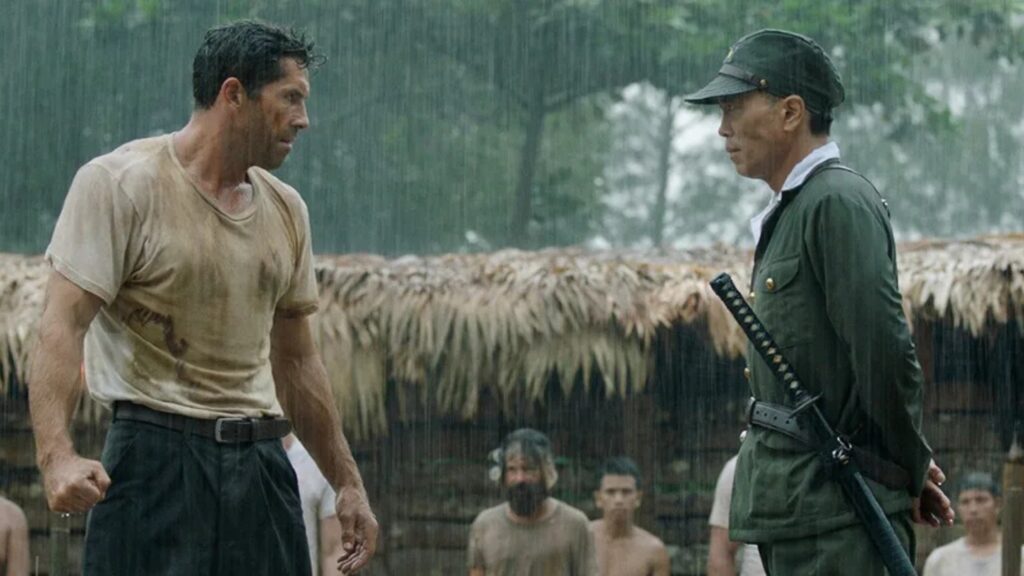Basic Info & Context.
Prisoner of War is a 2025 American war-martial-arts film directed by Louis Mandylor and written by Marc Clebanoff (story by Scott Adkins).
Runtime: ~112 minutes.
Premise: Set during World War II, the story follows a British RAF Wing Commander (or SAS officer, depending on source) who is captured by Japanese forces in the Philippines (Battle of Bataan) and forced into brutal hand-to-hand combat matches in a prisoner-of-war camp.
Release: The film premiered at the Beverly Hills Film Festival in April 2025; a limited theatrical and digital release in the U.S. on September 19, 2025.
Genre: War / action / martial arts. Combines POW war film tropes with martial-arts combat.
Cast & Means Character.
Here are some of the principal cast members:
- Scott Adkins as James Wright (British officer).
- Peter Shinkoda (as the camp commander Lt. Col. Ito).
- Michael Copon.
- Donald “Cowboy” Cerrone.
- Gabbi Garcia.
- Michael Rene Walton, Gary Cairns, Shane Kosugi, Masanori Mimoto appear among the supporting cast.
In total, the film has around 8-12 named credited actors with significant roles (Wright, camp commander(s), other POWs, supporting roles) — though many additional minor characters fill out the POW camp, guards, training fights etc.
Means Character.
The film is anchored by James Wright, played by Scott Adkins. We enter the story through his capture, his forced fighting, his strategy and survival. The audience is aligned with his training, his moral choices, his physical battles. Therefore Wright is the “means character” — the character through whose eyes and actions much of the story flows, and whose decisions carry the narrative weight.
While other characters (fellow prisoners, the commander, etc) contribute, Wright is the central figure: his martial arts history, his resistance to the camp, his escape plan. Reviewers note that the film is very much “a showcase for Adkins” in the way Wright’s physicality and moral arc drive the film.
Box Collection & Commercial Picture.
Because Prisoner of War is a limited release war-action film (martial arts + war hybrid) rather than a major blockbuster, its financial success is more modest and specialized.
- The film is distributed by Well Go USA Entertainment in the U.S.
- As of public sources, there is no wide-release box-office figure prominently cited for this film as of yet.
- Critical reception: On Rotten Tomatoes the film currently has a Tomatometer of ~67% based on 15 reviews.
- Reviewers highlight that the film is designed largely for martial-arts/war-film fans rather than mainstream wide audience; its value lies in action spectacle and niche appeal more than mass commercial return.
In short: The “box collection” in a traditional sense is not headline-making. The film likely succeeds if it finds its audience via VOD, streaming, martial-arts/war-film aficionados, and genre circuits rather than wide theatrical dominance.
Niche, Tone & Thematic Domain.
Genre / Niche
Prisoner of War occupies a hybrid niche: war film (POW, World War II, prisoner camp) plus martial-arts action (hand-to-hand combat inside the camp, tournament-style fighting). This is a relatively unique combination: rather than purely historical war drama, the film emphasises physical combat spectacle. It appeals to fans of martial-arts stars (Scott Adkins) and war-movie settings alike.
Tone & Themes
- The tone is brutal, raw, visceral. The POW camp scenes are dark and oppressive; the fighting sequences are explicit and physically driven. Reviewers caution about the “harsh violence” and “martial arts war epic” feel.
- Themes include: survival against odds; oppression and resistance; physical training as metaphor for moral endurance; camaraderie among prisoners; vengeance and escape.
- Also the film touches on the legacy of the Battle of Bataan, Japanese POW camp horrors, forced fights, death matches for captor amusement. By fusing martial arts into these wartime atrocities, the film emphasises the physical body as site of both suffering and heroism.
- The narrower niche of “martial-arts war film” means the film isn’t focused as much on large-scale war strategy or political nuance, but more on combat, individual skill, survival by strength and cunning. Reviewers note the narrative depth may be light compared to war epics, but the action is central.

Deep Narrative & Analysis.
Story Overview
The film opens with our protagonist James Wright being shot down (or otherwise captured) in the Philippines during World War II (Battle of Bataan). He is taken to a Japanese-run POW camp where the Allied soldiers are forced into brutal labor and, in this narrative, forced into hand-to-hand combat matches for the amusement of their captors.
Wright, however, has significant martial arts training (in Hong Kong per the trailer synopsis) which gives him an edge in these matches and makes him a target of the camp commander, Lt. Col. Ito (Peter Shinkoda). Wright ends up using his skills not only to survive fights, but to inspire fellow prisoners, plan an escape, and challenge the camp’s cruelty. The film weaves in the atrocities of the POW camp, the training sequences and the eventual breakout/escape plan.
Structure & Key Beats
- Setup: Wright’s capture, the harsh conditions of the camp, the introduction of the forced-combat concept.
- Middle: Wright’s initial fight(s), his realization of what the camp is doing, his alliances with fellow prisoners (American Captain Collins, Filipino sergeant Villanueva) and local nurse Theresa (Gabbi Garcia) who aids them. The film builds on his martial-arts skill being central to survival, and the tension between compliance and resistance.
- Climax: The escape attempt, the aerial bombardment context, Wright’s final confrontation with Ito (and dojo scene framing), and the personal duel that ties back to Wright’s earlier training and the camp’s cruelty. The final action is intense and visceral, though some critics say the escape narrative is “under-developed.”
- Resolution: Wright escapes (or is on the way to freedom), and the final scenes show the consequences and echoes of his fighting in the present (flashback/dojo framing). The film ends with a sense of survival, but not necessarily full closure — fitting for a war film of this type.
What Works
- Fight choreography and physical action: Many reviews praise the combat sequences, seeing them as a highlight. RogerEbert’s review states: “a fine showcase for the British mixed martial artist… whenever it’s only about a man of action.”
- Scott Adkins’ commitment: Adkins is known in the martial arts genre and the film gives him a platform to display physical skill, presence and heroism. The trailer emphasises that his martial arts training is central.
- Setting & concept twist: The idea of forced combat in a POW camp is an unusual twist on the war genre, combining POW survival with tournament-style fighting. This gives the film a unique identity among war-films.
- Genre melding: For audiences who like action war films and martial-arts, this film offers a crossover.
What Doesn’t Quite Land
- Narrative depth & character development: Multiple reviews point out that supporting characters lack development; the emotional stakes outside the fights are weaker. RogerEbert writes that “there’s little emotional investment in them [fellow prisoners]” and that narrative logic only takes the film so far.
- Historical realism & tone ambiguity: Some critics view the film as less serious war drama and more “martial-arts set piece in a war camp,” which may disappoint viewers seeking detailed historical authenticity. For example, Rotten Tomatoes summary indicates it’s “Too silly to fully convince, but too serious to enjoy as escapism.”
- Limited theatrical/fanbase reach: Because the film is niche, it may not achieve broad mainstream appeal; if the viewer expects blockbuster war-epic scale, the film’s moderate budget and focus on hand-to-hand fighting may feel contained.
Why This Prisoner of War Film Matters.
- It shines a spotlight on a war film that emphasises physical survival and martial discipline rather than large‐scale battles. For fans of action/martial arts, it’s a refreshing crossover into war genre.
- It expands the kinds of war narratives told: not just tanks and great offensives, but captivity, forced combat, personal survival in extreme conditions.
- It gives a martial-arts specialist (Scott Adkins) a chance to lead a Prisoner of War film, which is rare and might open more hybrid genre possibilities.
- For genre-enthusiasts, it reminds us that there is space for mid-budget, targeted films in a marketplace dominated by tentpole budgets and streaming mega-releases.
Final Thoughts — Is It Worth Your Time?
Yes — if you are someone who enjoys tightly framed action movies, martial-arts film stars, and war settings with a high body-count of physical courage rather than political strategy. Prisoner of War delivers the spectacle of combat, the tension of captivity, and the heroics of one man physically resisting overwhelming odds.
If you prefer elaborate war dramas, historical nuance, large ensemble arcs, deep character psychology or sprawling battlefields, you might find the film somewhat limited in scope. But that’s not the aim here: the aim is visceral, physical, focused survival.
In sum: Prisoner of War is an intense genre entry, a bruising action movie with war credentials. It may not redefine the war film genre, but it carries its hybrid identity with conviction. If you’re ready for a martial-arts war thriller, give it a watch.





